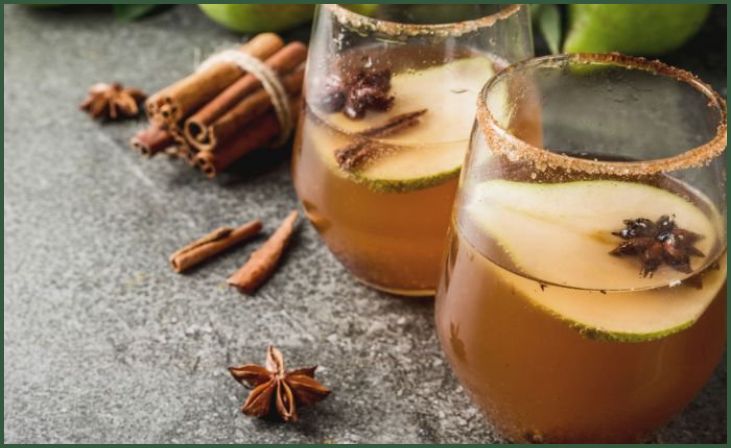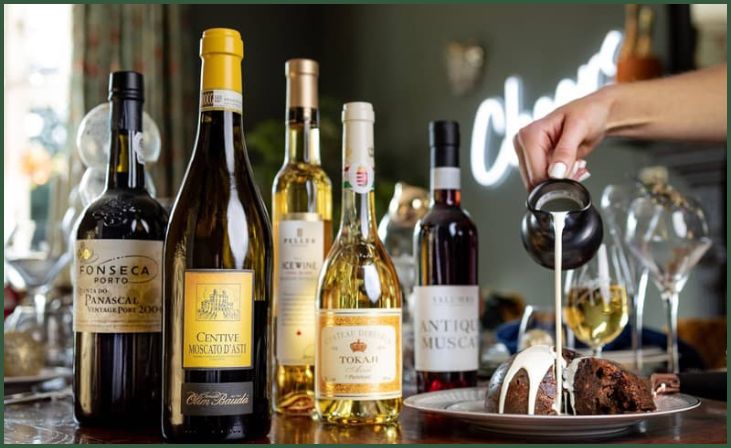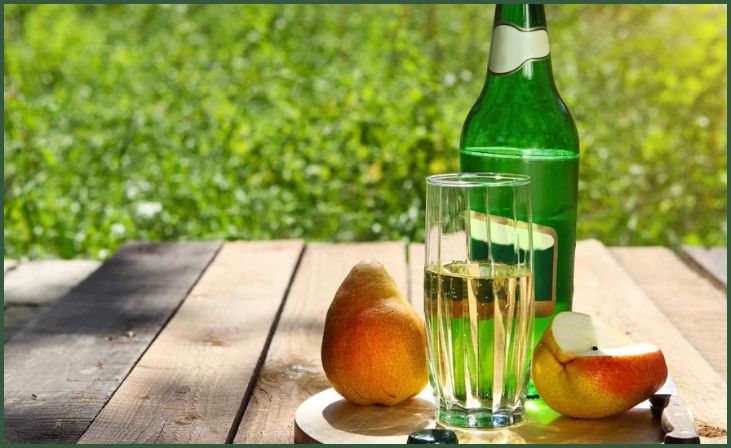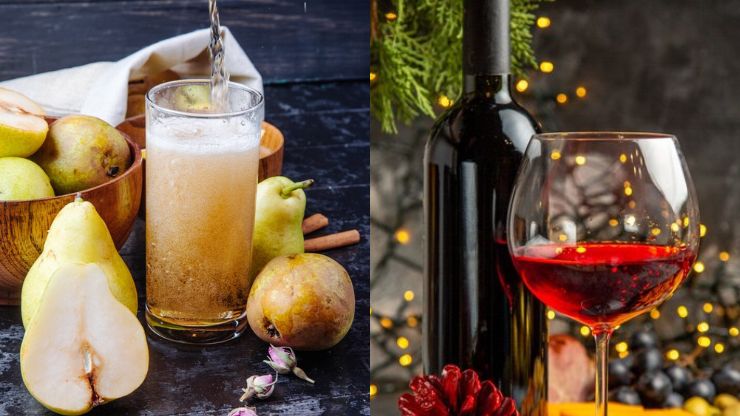Pear Cider vs Wine – Craving a tantalizing drink that tantalizes your taste buds? Look no further than the delightful debate between pear cider and wine. Delve into the world of these two beverages to uncover their unique characteristics, flavors, and the perfect occasions to enjoy them. Whether you’re a wine aficionado or a cider enthusiast, this guide will help you discern which option best suits your palate.
Table of Contents
TogglePear Cider vs Wine: 15 Differences
Base Ingredient

Pear cider, a delightful beverage, finds its origin in the fermentation of luscious pear juice. This process involves carefully selecting ripe and flavorful pears, which are then pressed to extract their juice. The extracted juice serves as the primary ingredient, undergoing fermentation to create the crisp and refreshing pear cider.
On the other hand, the art of winemaking revolves around the fermentation of carefully cultivated grapes. The process begins with the harvesting of specific grape varieties, followed by pressing the grapes to extract their juices, which serve as the fundamental component for crafting the diverse array of wines available. This is the first difference on our list of Pear Cider vs Wine: 15 differences.
Production Process
The brewing process of pear cider mirrors that of beer, involving specific steps such as milling the pears, extracting the juice, and fermenting it with the help of yeast. This process results in a beverage with a delicate balance of sweet and tart flavors.
In contrast, the production of wine encompasses a diverse range of techniques depending on the desired wine type. From crushing and pressing the grapes to fermentation, clarification, and aging, each step contributes to the intricate and nuanced flavors found in various wine varieties across the globe. This is the second difference on our list of Pear Cider vs Wine: 15 differences.
Also Read: Salt Preserved Limes
Alcohol Content
When it comes to alcohol content, wine typically boasts a higher percentage compared to pear cider. This distinction arises from the variations in the fermentation processes between the two beverages.
The fermentation of grapes often yields a higher alcohol concentration, contributing to the characteristic warmth and depth found in various wine styles. In contrast, the fermentation of pears results in a lower alcohol content, creating a lighter and more refreshing drinking experience. This is the third difference on our list of Pear Cider vs Wine: 15 differences.
Sugar Content
Pear cider tends to retain more residual sugars compared to most wines, offering a slightly sweeter taste profile. This higher sugar content contributes to the naturally sweet and fruity essence of pear cider, making it a popular choice among individuals who enjoy beverages with a subtle hint of sweetness.
Conversely, the fermentation process of grapes in winemaking often leads to a more complete conversion of sugars into alcohol, resulting in drier wine varieties with minimal residual sugar. This is the fourth difference on our list of Pear Cider vs Wine: 15 differences.
Acidity
A notable disparity between pear cider and wine lies in their respective levels of acidity. Wine, known for its tangy and sometimes robust taste, typically boasts a higher acidity level, contributing to its characteristic tartness. This acidity plays a crucial role in balancing the flavors and providing a vibrant and refreshing drinking experience.
In contrast, pear cider tends to exhibit lower acidity, resulting in a smoother and more approachable taste profile, which appeals to those seeking a milder and less tart beverage option. This is the fifth difference on our list of Pear Cider vs Wine: 15 differences.
Tannins
While some wines contain tannins, a class of compounds found in grape skins, seeds, and stems, pear cider generally lacks this component. Tannins contribute to the structure and mouthfeel of wine, imparting astringency and complexity to the overall taste profile.
In the absence of tannins, pear cider offers a smoother and more straightforward drinking experience, making it an appealing option for those who prefer beverages with a lighter and more fruit-forward taste. This is the sixth difference on our list of Pear Cider vs Wine: 15 differences.
Aging Process
The aging process significantly distinguishes the two beverages, as wines often benefit from extended periods of aging to enhance their flavors and develop more complex characteristics. Various factors, such as the type of grape, the aging vessel, and the duration of the aging process, contribute to the final flavor profile of the wine.
On the other hand, pear cider is typically consumed fresh to preserve its vibrant and fruity essence, as prolonged aging may compromise the crisp and refreshing qualities that define this beloved beverage. This is the seventh difference on our list of Pear Cider vs Wine: 15 differences.
Also Read: Preserving the Harvest for Winter
Varieties and Flavors

Wine enthusiasts are treated to an extensive array of flavors stemming from the diverse grape types, cultivation methods, and winemaking techniques employed across different regions. This rich variety contributes to the complex taste profiles found in red, white, and rosé wines, each offering unique aromas and flavor nuances.
Don't just scroll, subscribe!
BuzzTrail's unique web-stories are the cure for boredom you've been waiting for.
In contrast, the flavor variations of pear cider stem from the use of different pear varieties, each imparting its distinct sweetness, acidity, and aroma to the final product. Whether it’s a delicate and floral note or a robust and juicy essence, pear ciders offer a diverse range of flavor profiles to satisfy varying preferences.
Cultural Significance
Wine holds profound cultural and historical significance in various societies worldwide, serving as an integral part of religious ceremonies, social gatherings, and culinary traditions. Throughout history, wine has been celebrated for its association with celebration, sophistication, and the art of winemaking.
In contrast, pear cider, while also cherished in certain regions, is often tied to more localized traditions and holds a distinct cultural significance within specific communities that value the unique flavors and heritage associated with this fruity beverage.
Food Pairings
Wine’s versatility in food pairings is widely celebrated, with its diverse flavor profiles complementing a wide array of cuisines. From rich meats and savory cheeses to decadent desserts, wine’s acidity and tannins often serve to balance and enhance the flavors of various dishes.
On the other hand, pear cider shines when paired with lighter fare, such as fresh salads, charcuterie boards, and certain desserts. Its natural sweetness and refreshing acidity serve as a delightful accompaniment to dishes that benefit from a fruit-forward and slightly sweet contrast.
Occasions
Wine has long been associated with formal gatherings, celebratory events, and special occasions, where its cultural significance and sophisticated reputation make it a popular choice among connoisseurs and enthusiasts. Its presence at elegant dinners, weddings, and upscale events contributes to its status as a beverage for momentous and ceremonial gatherings.
In contrast, pear cider is often favored at more casual events, outdoor gatherings, and laid-back social occasions, where its light and refreshing qualities perfectly complement the relaxed and convivial atmosphere.
Serving Temperature
The recommended serving temperature for pear cider is typically chilled, allowing its crisp and fruity flavors to shine. Serving it at a colder temperature helps enhance the refreshing qualities of the beverage, making it a popular choice for warm weather and outdoor activities.
In contrast, the serving temperature for wine varies depending on the type and style. While some wines are best served slightly chilled to preserve their vibrant flavors, others benefit from being served at room temperature to allow their complex aromas and flavors to fully develop and unfold.
Carbonation
Pear cider often boasts a natural effervescence, contributing to its lively and refreshing drinking experience. This natural carbonation elevates the sensory appeal of pear cider, creating a playful and bubbly texture that enhances its crisp and fruity taste profile.
On the other hand, while some wine varieties may undergo secondary fermentation to introduce carbonation, the majority of wines lack the effervescence commonly found in pear cider, offering a more straightforward and smooth drinking experience without the presence of bubbles.
Color
The visual aspect of both beverages sets them apart, with wines exhibiting a wide spectrum of colors, ranging from deep, robust reds to pale, golden yellows and various shades in between. This diverse color palette is a result of different grape varieties, winemaking techniques, and aging processes, contributing to the visually striking appearance of different wine types.
In contrast, pear cider typically presents a light, golden hue, reflecting the natural color of the pears used in the brewing process. This radiant and inviting color further enhances the perception of pear cider as a refreshing and approachable beverage option.
Market Availability

Wine enjoys global availability, with a diverse selection of renowned wine-producing regions across the world catering to the preferences of wine enthusiasts everywhere. From well-established wine-producing countries to emerging regions, the global wine market offers a vast array of options for consumers to explore and enjoy.
On the other hand, the availability of pear cider may be more regionally specific, depending on the local cultivation of pears and the prevalence of traditional brewing practices within certain communities. This localized availability adds a touch of exclusivity and uniqueness to the experience of discovering and savoring different types of pear cider based on specific geographical locations.
Also Read: How Does Alcohol Fermentation Work
Conclusion
In the realm of libations, the choice between pear cider and wine rests on personal preferences and the occasion at hand. While pear cider delights with its refreshing fruitiness, wine entices with its rich complexity.
Both have their place, be it a casual gathering, a festive celebration, or a quiet evening. So, embrace the diversity of flavors and raise a toast to the delightful diversity that pear cider and wine bring to our glasses. Cheers to a life filled with delicious choices!
FAQs
Is pear cider healthier than wine?
Is pear cider healthier than wine?
While both pear cider and wine offer certain health benefits, their nutritional profiles differ. Pear cider, typically lower in alcohol content and calories, can be a lighter alternative to wine. However, moderate consumption of either can contribute to a balanced lifestyle.
What distinguishes the taste of pear cider from wine?
What distinguishes the taste of pear cider from wine?
The key lies in the fruit base and fermentation process. Pear cider boasts a refreshing, fruity flavor with subtle hints of sweetness, while wine presents a complex taste influenced by the grape variety, region, and aging process. Whether you prefer the crispness of pears or the depth of grapes, each offers a unique tasting experience.

